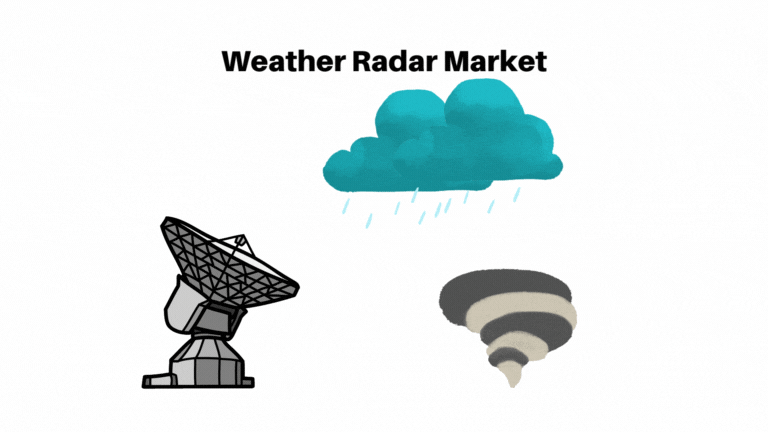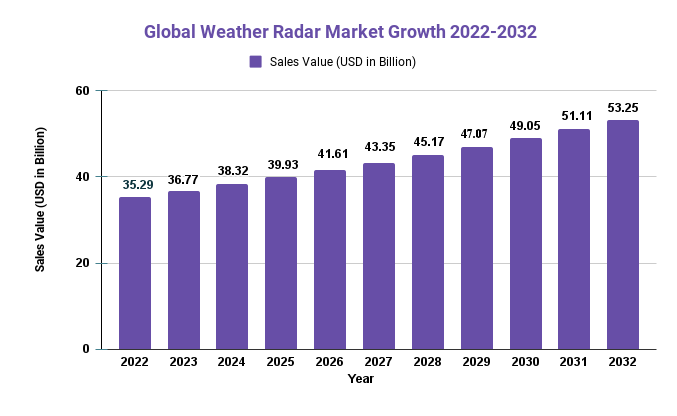Weather Radar Market Size Is Set To Expand With CAGR Of 4.20% By 2032

Page Contents
Market Overview
Published Via 11Press: The Weather Radar Market size is expected to be worth around USD 53.25 Bn by 2032 from USD 35.29 Bn in 2022, growing at a CAGR of 4.20% during the forecast period from 2022 to 2032.
The weather radar market has been growing steadily in recent years, driven by increasing demand for accurate and reliable weather information across a range of industries. Weather radars have become an essential tool for meteorologists, air traffic controllers, agriculturalists, and emergency responders alike.
One of the key drivers of the weather radar market is the increasing frequency and severity of extreme weather events around the world. As these events become more common, there is a growing need for advanced warning systems that can help communities prepare for the impacts of severe storms, floods, and other climate-related disasters.
At the same time, advances in technology are also fueling growth in the weather radar market. New sensors and data processing techniques are improving accuracy and reliability while reducing costs. This is making it easier than ever before to deploy weather radar systems in even the most remote locations around the globe.
Request For Sample Report Here: https://market.us/report/weather-radar-market/request-sample/

Key Takeaways
- The growing need for accurate and timely weather data is fueling the growth of the weather radar market.
- Weather radar systems are employed in a number of industries, such as aviation, maritime, and agriculture they're even utilized by government agencies.
- Modern technologies such as dual-polarization radar and phased array radar have spurred innovation in the weather radar market.
- North America is currently the leading market for weather radar systems, but analysts anticipate a significant expansion in Asia-Pacific over the coming years.
- The weather radar market is expected to see continued growth as climate change causes more extreme weather events, necessitating the need for sophisticated monitoring and prediction systems.
Regional Analysis
- North America is currently the leading market for weather radar systems due to the high frequency of severe weather events in this region. The United States has invested heavily in weather monitoring and forecasting services through NOAA (National Oceanic and Atmospheric Administration).
- Europe is a major market for weather radar systems, with countries such as the United Kingdom, Germany, and France leading the charge. This growth is being spurred on by an increasing need for accurate weather data in industries like aviation and maritime.
- The Asia-Pacific region is projected to experience significant growth in the weather radar market over the coming years due to government investments in new weather monitoring and forecasting systems in countries like India and China. Furthermore, an increasing need for accurate and timely weather data for agriculture purposes and disaster preparedness is fuelling this growth within this region.
- Middle East and Africa Although the Middle East and Africa region is a small market for weather radar systems, it is expected to expand in the coming years as governments invest in improved monitoring and forecasting systems to support industries such as aviation and agriculture.
- The Latin American market for weather radar systems is relatively small but is expected to expand over the coming years due to an increasing need for weather monitoring and forecasting services in industries such as agriculture, mining, and transportation.
Purchase This Report At Discounted Rate Here: https://market.us/purchase-report/?report_id=11919
Drivers
Growing Need for Accurate and Timely Weather Data As extreme weather events become more frequent and severe, there is an increasing need for accurate, real-time weather data to assist decision-making across numerous industries. Investments in Weather Monitoring and Forecasting Infrastructure Governments and organizations around the world are investing in new weather monitoring and forecasting systems, such as radar systems, to enhance their capacity to anticipate and respond to extreme weather events.
Advances in Weather Radar Technology Modern technologies such as dual-polarization radar and phased array radar have significantly enhanced the accuracy and speed of weather radar systems, making them more valuable for a wider variety of applications. Rising Demand for Aviation and Maritime Safety Weather radar systems are essential tools in ensuring the safety of aviation and maritime operations, driving up demand for these services in the weather radar market. Growing Recognition of Climate Change Impact As climate change becomes more apparent, there is increasing recognition that better weather monitoring and forecasting are necessary to prepare for and mitigate extreme weather events. This has spurred the growth of weather radar markets in numerous regions around the world.
Restraints
The high cost of Weather radar systems can be expensive to develop and deploy, which could limit their adoption in some regions or by some organizations with limited budgets. Limitations of weather radar technology While advancements in weather radar technology have improved the accuracy and speed of these systems, there are still limitations to what they can detect and predict, particularly for severe weather events. Limited geographic coverage Weather radar systems have a limited range, which means that multiple systems may be needed to cover large areas, increasing the cost and complexity of deployment.
Competition from alternative weather monitoring technologies There are alternative technologies available for weather monitoring, such as satellite imaging and ground-based weather stations, which could compete with weather radar systems in certain applications. Regulatory and environmental factors Deploying weather radar systems can require regulatory approvals and may also have environmental impacts, such as the need for tower construction and potential effects on wildlife. These factors could limit the deployment of weather radar systems in some regions or for some applications.
Opportunities
Growth of the Weather Radar Market in Aviation With an ever-increasing number of flights and air traffic, there has been an enormous growth in demand for accurate weather data in recent years. Weather radar plays an increasingly important role in helping pilots avoid hazardous conditions and maintain safe flights, making it essential to have access to this technology within aviation. As a result, this market for weather radar systems is expected to remain dominant over the coming years. Weather radar adoption in agriculture, Agriculture is highly dependent on weather conditions, so farmers need accurate weather data to make informed decisions about planting, irrigation, and harvesting. Weather radar can provide invaluable data about precipitation, wind patterns, and other weather patterns making it a key tool for farmers and other agricultural stakeholders alike.
Weather radar's expanding role in disaster management Weather radar plays an essential role in forecasting and monitoring severe weather events like hurricanes, tornadoes, and floods. Government agencies and first responders use weather radar data to track weather systems and issue timely warnings to communities affected by them. Advances in Technology Rapid advances in technology have led to the development of advanced weather radar systems with superior accuracy and coverage. This has created new opportunities for companies to create creative solutions tailored to customers' evolving needs. Emerging Markets The weather radar market is expected to experience significant growth in emerging regions such as Asia-Pacific and Latin America, where governments are investing in infrastructure and technology to enhance weather forecasting capabilities.
Overall, the weather radar market offers significant opportunities for companies that can develop innovative solutions tailored to a variety of industries and applications.
Challenges
High Costs Weather radar systems can be costly to install and maintain, especially for smaller companies or organizations with tight budgets. As a result, their adoption in certain markets or applications may be restricted due to their high costs. Limited Coverage Weather radar systems can provide accurate data on localized weather conditions, but their coverage may be limited beyond that area. This makes it difficult to accurately forecast patterns across larger areas or for extended periods of time. Competition from Alternative Technologies Weather radar has long been the go-to tool for forecasting weather conditions, but satellite imagery and numerical weather prediction models are becoming more widely used. These more comprehensive and precise solutions may one day replace weather radar as a primary tool in this market.
Data Quality Issues Weather radar data accuracy can be compromised due to various factors, such as interference from other radar systems, atmospheric conditions, and signal processing errors. These elements combine to diminish the quality of information produced by these systems making it harder to provide precise weather forecasts with complete confidence. Regulatory Challenges Weather radar systems may be subject to regulatory requirements and standards that differ between countries or regions. Complying with these regulations adds additional costs and complexity to the development and deployment of weather radar systems.
Overall, the weather radar market faces several obstacles that could hinder its growth and development. Companies operating in this space must devise strategies to overcome these difficulties and seize opportunities presented by an increasing need for accurate weather forecasting and monitoring solutions.
Report Scope
| Report Attribute | Details |
| The market size value in 2022 | USD 35.29 Bn |
| Revenue forecast by 2032 | USD 53.25 Bn |
| Growth Rate | CAGR Of 4.20% |
| Regions Covered | North America, Europe, Asia Pacific, Latin America, and Middle East & Africa, and the Rest of the World |
| Historical Years | 2017-2022 |
| Base Year | 2022 |
| Estimated Year | 2023 |
| Short-Term Projection Year | 2028 |
| Long-Term Projected Year | 2032 |
Key Market Segments
Type
- Airborne Weather Radar
- Land-based Weather Radar
Application
- Meteorology & Hydrology
- Aviation Sectors
- Military
Key Market Players
- Honeywell
- Enterprise Electronics Corporation (EEC)
- Selex ES GmbH
- EWR Weather Radar
- Vaisala
- Beijing Metstar Radar Co., Ltd.
- China Electronics Corporation
- Toshiba
- GAMIC
- China Electronic Technology Group Corporation (CETC)
Frequently Asked Questions
What is the market study period?
The Weather Radar Market is studied from 2017 – 2032.
What is the growth rate for the Weather Radar Market?
The Weather Radar Market is growing at a CAGR of 4.20%
Which region experiences the highest rate of growth in the Weather Radar Market?
Asia Pacific is growing at the highest CAGR over 2022- 2032.
Which region is the largest in the Weather Radar Market?
North America holds the highest share in 2022.
Who are the major players in the Weather Radar Market?
Honeywell, Enterprise Electronics Corporation (EEC), Selex ES GmbH, EWR Weather Radar, Vaisala, Beijing Metstar Radar Co., Ltd., China Electronics Corporation, Toshiba, GAMIC, China Electronic Technology Group Corporation (CETC)
The team behind market.us, marketresearch.biz, market.biz and more. Our purpose is to keep our customers ahead of the game with regard to the markets. They may fluctuate up or down, but we will help you to stay ahead of the curve in these market fluctuations. Our consistent growth and ability to deliver in-depth analyses and market insight has engaged genuine market players. They have faith in us to offer the data and information they require to make balanced and decisive marketing decisions.



